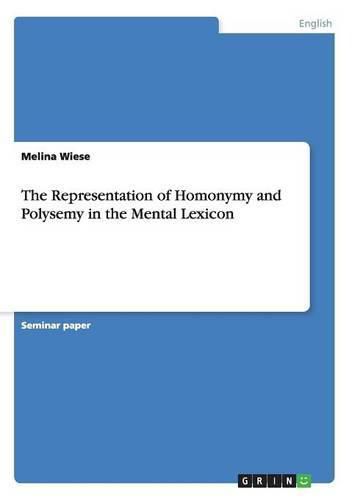Readings Newsletter
Become a Readings Member to make your shopping experience even easier.
Sign in or sign up for free!
You’re not far away from qualifying for FREE standard shipping within Australia
You’ve qualified for FREE standard shipping within Australia
The cart is loading…






Seminar paper from the year 2015 in the subject English Language and Literature Studies - Linguistics, grade: 1,0, University of Bonn (Anglistik), course: Language in the Mind, language: English, abstract: When homonymous meanings are assumed to have separate representations in the human mind does this count for polysemous senses and does the processing advantage differ between homonymous and polysemous words? Since this is a very new perspective in psycholinguistics, not many results have been achieved by now. Thus, this study aims to go further and explain ‘the source of the processing advantage’ which could have been observed in previous lexical decision studies with ambiguous words. In addition this study will focus on the diverse processing advantages for homonyms and polysemes and attempts to provide a model for the word representation of homonymous and polysemous words. Accordingly, the experiment is constituted as a lexical decision task. The used corpus was adopted from the study of Rodd et al. (2002: 263-264) which built the base for this study. This corpus was used because the present study only included 20 participants which thus only allows a predication to a limited extent. But by choosing this corpus parallels can be drawn between those two experiments and thereby a more general and meaningful statement can be provided.
$9.00 standard shipping within Australia
FREE standard shipping within Australia for orders over $100.00
Express & International shipping calculated at checkout
Seminar paper from the year 2015 in the subject English Language and Literature Studies - Linguistics, grade: 1,0, University of Bonn (Anglistik), course: Language in the Mind, language: English, abstract: When homonymous meanings are assumed to have separate representations in the human mind does this count for polysemous senses and does the processing advantage differ between homonymous and polysemous words? Since this is a very new perspective in psycholinguistics, not many results have been achieved by now. Thus, this study aims to go further and explain ‘the source of the processing advantage’ which could have been observed in previous lexical decision studies with ambiguous words. In addition this study will focus on the diverse processing advantages for homonyms and polysemes and attempts to provide a model for the word representation of homonymous and polysemous words. Accordingly, the experiment is constituted as a lexical decision task. The used corpus was adopted from the study of Rodd et al. (2002: 263-264) which built the base for this study. This corpus was used because the present study only included 20 participants which thus only allows a predication to a limited extent. But by choosing this corpus parallels can be drawn between those two experiments and thereby a more general and meaningful statement can be provided.